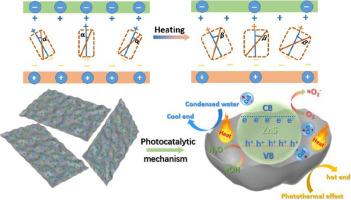Synergizing photothermal and pyroelectric effects: Coal gangue assisted simultaneous ZnS/CuS for degradation of mineral processing wastewater
IF 6.3
2区 工程技术
Q1 ENGINEERING, CHEMICAL
引用次数: 0
Abstract
Photocatalytic oxidation technology is a green and low carbon approach for degradation of mineral processing wastewater, which is extensively applied to ecological environment restoration. In this research, coal gangue-ZnS/CuS pyroelectric/photothermal composite photocatalyst is constructed by high temperature calcination method. The temperature difference between heat converted from light energy absorbed by CuS and the circulating condensate water provides the impelling force for the pyroelectric effect. The porous structure of coal gangue acts as a “heat capacitor”, which furnishes greater temperature fluctuation for pyroelectric effect. Furthermore, the hydroxyl groups on the surface of coal gangue can availably adsorb oxygen and facilely form superoxide radicals with electrons. The degradation efficiency of xanthate is as high as 99.5 % within 50 min. This research has significant implications for designing and developing highly efficient photocatalysts for the degradation of mining wastewater.

光热和热电效应的协同作用:煤矸石辅助 ZnS/CuS 同时降解选矿废水
光催化氧化技术是一种绿色低碳的选矿废水降解方法,被广泛应用于生态环境修复。本研究采用高温煅烧法构建了煤矸石-ZnS/CuS热电/光热复合光催化剂。CuS 吸收光能转化的热量与循环冷凝水之间的温差为热释电效应提供了推动力。煤矸石的多孔结构就像一个 "热电容器",为热释电效应提供了更大的温度波动。此外,煤矸石表面的羟基可以吸附氧气,并容易与电子形成超氧自由基。在 50 分钟内,黄原酸盐的降解效率高达 99.5%。这项研究对设计和开发用于降解采矿废水的高效光催化剂具有重要意义。
本文章由计算机程序翻译,如有差异,请以英文原文为准。
求助全文
约1分钟内获得全文
求助全文
来源期刊

Journal of water process engineering
Biochemistry, Genetics and Molecular Biology-Biotechnology
CiteScore
10.70
自引率
8.60%
发文量
846
审稿时长
24 days
期刊介绍:
The Journal of Water Process Engineering aims to publish refereed, high-quality research papers with significant novelty and impact in all areas of the engineering of water and wastewater processing . Papers on advanced and novel treatment processes and technologies are particularly welcome. The Journal considers papers in areas such as nanotechnology and biotechnology applications in water, novel oxidation and separation processes, membrane processes (except those for desalination) , catalytic processes for the removal of water contaminants, sustainable processes, water reuse and recycling, water use and wastewater minimization, integrated/hybrid technology, process modeling of water treatment and novel treatment processes. Submissions on the subject of adsorbents, including standard measurements of adsorption kinetics and equilibrium will only be considered if there is a genuine case for novelty and contribution, for example highly novel, sustainable adsorbents and their use: papers on activated carbon-type materials derived from natural matter, or surfactant-modified clays and related minerals, would not fulfil this criterion. The Journal particularly welcomes contributions involving environmentally, economically and socially sustainable technology for water treatment, including those which are energy-efficient, with minimal or no chemical consumption, and capable of water recycling and reuse that minimizes the direct disposal of wastewater to the aquatic environment. Papers that describe novel ideas for solving issues related to water quality and availability are also welcome, as are those that show the transfer of techniques from other disciplines. The Journal will consider papers dealing with processes for various water matrices including drinking water (except desalination), domestic, urban and industrial wastewaters, in addition to their residues. It is expected that the journal will be of particular relevance to chemical and process engineers working in the field. The Journal welcomes Full Text papers, Short Communications, State-of-the-Art Reviews and Letters to Editors and Case Studies
 求助内容:
求助内容: 应助结果提醒方式:
应助结果提醒方式:


